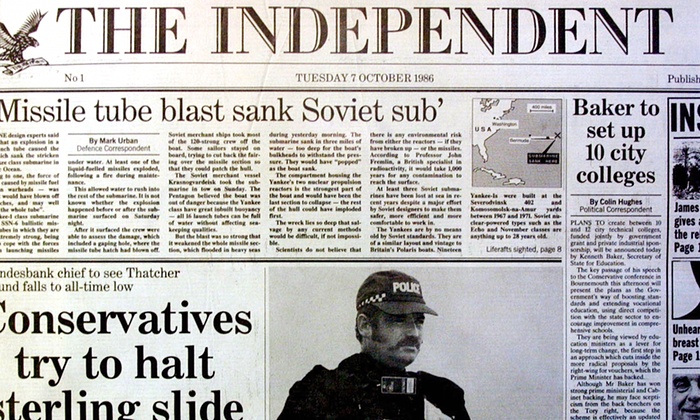
The moment had long been anticipated in the office the three Independent titles and the London Evening Standard have shared since autumn 2013. But the announced closure of the Independent and its Sunday sister as print titles, spun into a story about the creation of the UK’s first digital-only national newspaper, was a shock nonetheless.
On Friday, staff were called to a meeting on the fourth floor balcony of Northcliffe House addressed by group CEO Steve Auckland and Independent editor Amol Rajan – no appearance from proprietor Evgeny Lebedev in person. There was an apology for the leak about talks to sell the i to Johnston Press; Rajan said how proud he felt of the Indy's fantastic staff.
There followed "town hall" meetings with HR. Management is talking in terms of new jobs rather than number of redundancies – a staff of 50 for the i, around a third of the Independent's current workforce, and reportedly 25 extra jobs on the website. Independent staff will be given priority for i jobs; the large number of casuals who work on the Indy, Sindy and i will not be. A very short window has been established for people to apply for new jobs. In light of multiple rounds of job cuts under the Lebedevs and their predecessors, one employee was stoical, telling Little Atoms that management has been "as fair as they can be".
Why the decision to sell the i and stop printing the Indy now, with substantial cost savings achieved since the Lebedevs took over? Outsiders looking at the presented figures might argue for loss-making, little-watched TV channel London Live to shut instead – but it’s vital face-saving for it to reach the end of its three year licence in March 2017.
"The Independent’s circulation is now less than the number of UK retailers that sell newspapers"
There is good reason, insiders say, for scepticism about figures blurred by cross-charging and cost absorption. The Independent has been losing more than claimed: around £5 million. The Indy’s 40,000 circulation, once bulks are stripped out, is now less than the number of UK retailers that sell newspapers. The i has plateaued too, and its 40p cover price can't be increased without it losing its USP as a value-for-money product. Steve Auckland's task of achieving "cost neutral" operations by September 2016 will be missed: the group has been hit by an unexpected downturn in advertising in the Evening Standard of 15 per cent year on year.
A final consideration is Evgeny Lebedev's reluctance to spend what he refers to as "his own money" on the titles, 18 months after his father stopped funding the papers. The £24 million deal with Johnston Press secures a pot to cover redundancy payments and investment in the Independent website and the Evening Standard: for Lebedev Juniorr, no-brainer.
Creating a strong web-only Independent brand presents a much bigger challenge than the one to keep the print paper afloat. Even with a shrunken readership, a physical paper has visibility and political clout, with its front page broadcast on Newsnight and stories dissected on Sunday breakfast TV. The Independent jumps headlong into the digital world as the fifth player in the market, behind the Mail, Guardian, Telegraph and Mirror. The Guardian has ploughed millions into its digital brand, at huge cost to its balance sheet, to build up 7.8 million unique daily browsers by June 2015.
Amol Rajan’s editor’s letter on Saturday promised huge, ambitious investment, new bureaux across the world and a new subscription mobile app. Is management prepared to invest to retain the journalistic names it has now and add more big hitters, then find a way to monetise the content?
Independent co-founder Stephen Glover remarked to Little Atoms that in the 1980s, the newly launched Indy "caught the zeitgeist – you saw young people wanting to be seen carrying [it]. It said something about them: it was beautifully designed, it had foreign correspondents in the Philippines, it was serious". He speaks highly of Rajan, for having "with a tiny budget, recreated something of the spirit of the early Independent. All the things I've said about transferring the values of the Indy to online, he would do". But will he, Glover asks, be in a position to do so? His role is to be that of a nebulous "editor-at-large"; he is shortly due to go on paternity leave. The Independent website for which Rajan developed the Voices opinion platform has subsequently gone big on clickbait, with around 80 per cent of the content it carries not appearing in the newspaper. Senior Independent journalists feel furious and "betrayed" by the route it has taken. Can this dissonance be addressed, and quality assured? One experienced freelancer at the titles said the print journalists are scathing of the paper's web offering: "How Lebedev thinks he can monetise it, with or without a paywall, is beyond us."
There’s an irony in Rajan’s retweets of messages from the Indy's well-wishers – they attest to the special character of the print titles at the same time as recognising, even if only in the choice of medium, that digital is the future. In an online world where people access news stories through social media and have little loyalty to titles, how will the Independent hold its own? As Glover observes, "there's an awful lot of stuff out there".